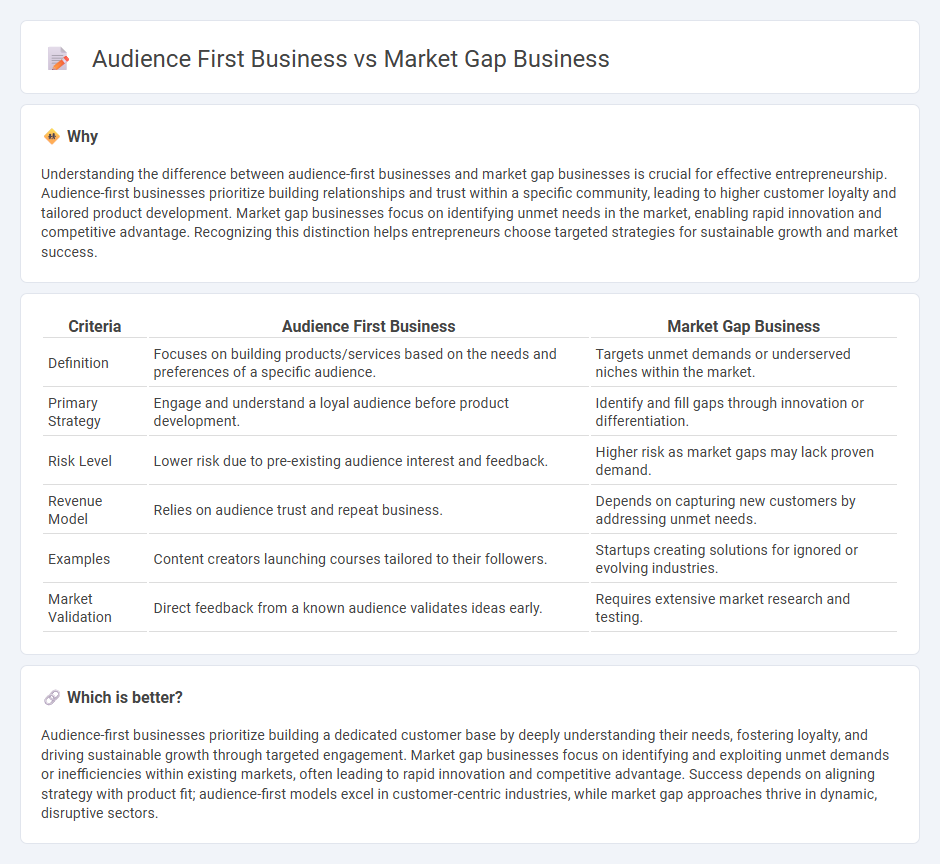
Entrepreneurship involves launching a first business by identifying unique market opportunities and addressing unmet customer needs. Successful entrepreneurs either introduce innovative products or services or exploit market gaps with tailored solutions that competitors overlook. Explore more about effective strategies to differentiate your startup in competitive markets.
Why it is important
Understanding the difference between audience-first businesses and market gap businesses is crucial for effective entrepreneurship. Audience-first businesses prioritize building relationships and trust within a specific community, leading to higher customer loyalty and tailored product development. Market gap businesses focus on identifying unmet needs in the market, enabling rapid innovation and competitive advantage. Recognizing this distinction helps entrepreneurs choose targeted strategies for sustainable growth and market success.
Comparison Table
| Criteria | Audience First Business | Market Gap Business |
|---|---|---|
| Definition | Focuses on building products/services based on the needs and preferences of a specific audience. | Targets unmet demands or underserved niches within the market. |
| Primary Strategy | Engage and understand a loyal audience before product development. | Identify and fill gaps through innovation or differentiation. |
| Risk Level | Lower risk due to pre-existing audience interest and feedback. | Higher risk as market gaps may lack proven demand. |
| Revenue Model | Relies on audience trust and repeat business. | Depends on capturing new customers by addressing unmet needs. |
| Examples | Content creators launching courses tailored to their followers. | Startups creating solutions for ignored or evolving industries. |
| Market Validation | Direct feedback from a known audience validates ideas early. | Requires extensive market research and testing. |
Which is better?
Audience-first businesses prioritize building a dedicated customer base by deeply understanding their needs, fostering loyalty, and driving sustainable growth through targeted engagement. Market gap businesses focus on identifying and exploiting unmet demands or inefficiencies within existing markets, often leading to rapid innovation and competitive advantage. Success depends on aligning strategy with product fit; audience-first models excel in customer-centric industries, while market gap approaches thrive in dynamic, disruptive sectors.
Connection
Audience-first business strategies focus on deeply understanding customer needs and preferences to tailor products and services effectively. Market gap businesses identify underserved areas within a market where demand exceeds supply or existing solutions fall short. Combining audience-first insights with market gap analysis enables entrepreneurs to create highly targeted offerings that address specific customer pain points and capture unmet demand.
Key Terms
Value Proposition
Market gap businesses identify unmet needs or underserved segments to tailor their value proposition, emphasizing innovation and differentiation. Audience-first businesses prioritize understanding customer behaviors, preferences, and pain points to craft personalized and relevant value propositions. Explore deeper insights to optimize your strategy for maximum market impact.
Product-Market Fit
Market gap businesses identify unmet needs or underserved segments, tailoring products to fill those specific voids and achieve rapid initial traction. Audience-first businesses prioritize understanding and nurturing a dedicated community before perfecting the product, ensuring sustained engagement and loyalty. Explore how balancing these approaches can optimize product-market fit and drive long-term success.
Customer Validation
Market gap businesses prioritize identifying unmet needs or underserved markets, enabling entrepreneurs to create innovative solutions with high growth potential. Audience-first businesses emphasize deep customer validation by engaging directly with their target audience to tailor products and services that resonate strongly, ensuring higher adoption and loyalty. Explore customer validation strategies to bridge market gaps effectively and build audience-centric success.
Source and External Links
From Idea to Reality: How to Identify a Market Gap - Thinslices - A market gap is a discrepancy between consumer needs and what is currently offered, representing opportunities for innovation by addressing unmet or poorly served demands through thorough research and trend analysis.
How To Find And Fill Gaps In The Market - Dovetail - Identifying gaps involves recognizing customer needs that aren't met by existing products or services, allowing businesses to gain first-mover advantage, capture market share, and increase revenue by offering unique solutions.
How to Identify Gaps in the Market - Hotjar - Market gaps are unmet or underserved customer needs that can be identified by methods such as customer feedback, competitor analysis, monitoring trends and social media, providing strategic opportunities to innovate and expand business reach.
 dowidth.com
dowidth.com